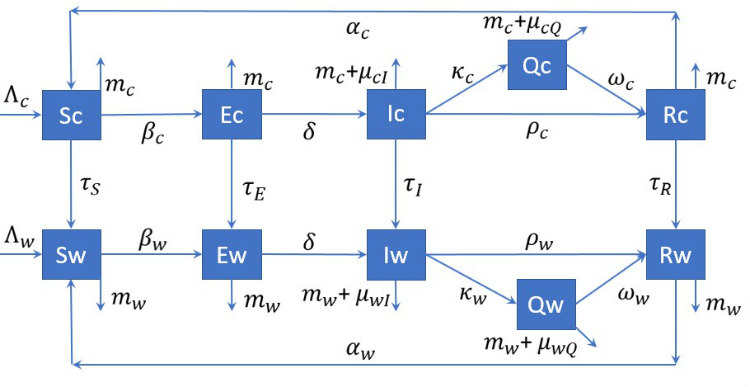Before many people were aware of the COVID-19 virus and its potential for broad infection, UMKC students were building predictive models of its possible spread.
Majid Bani-Yaghoub, Ph.D. (known as Dr. Bani), associate professor and chair of the Department of Mathematics and Statistics, focuses on mathematical modeling in several areas of study including health and biomedicine. He had been following the scientific reports of the new virus in China and incorporated it into his Graduate Differential Equations class.
“I was following the news in January, and I knew modeling and analysis of the virus would be a good fit with this course,” he says. “Our work is continuing. We have three different groups using epidemiology, math and statistical models and numerical simulations to see how the virus is affected by policy.”
In addition to following the progress of COVID-19, they are using optimal control theory, to predict the best way to minimize spread.
“Analyzing which combination of control measures gives us the best result and provides a good understanding of how to stop the spread of the virus,” Bani says.
Hope Mertz, MS ‘20, Science and Mathematics, studied the spread of COVID-19 for her research project. She was not that familiar with the virus when she enrolled.
“I had just started hearing about what was happening in China, so when Dr. Bani started talking about the project, my partner [Kodi Kuhlmann] and I jumped at the chance to work on something so pertinent.”
At the time, it appeared that the virus was only spreading in a small part of China. Bani shared the website for research articles at John Hopkins University and Mertz began to think that virus was spreading further and faster than reported.

“We modeled the spread from Wuhan City to New York City via their main travel hubs,” Mertz says. “We could see that the reported number of cases was a huge understatement. I could not force my model to give me numbers as small as what was being reported.”
Besides the student projects, research on COVID-19 has yielded successful collaborations with other faculty members. Using existing resources through the UMKC Institute for Data Education, Analytics and Science, Bani has recently started research on drug repurposing with Bi-Botti Celestin Youan at the School of Pharmacy and Liana Sega, also in the Mathematics and Statistics Department in the College of Arts and Sciences.
“There are millions of untested drugs,” he says. “We can use predictive modeling, machine learning techniques and some abstract areas of mathematics such as persistent homology to explore how we could use an existing drug as a solution for the problem.”
While he is certain of the quality of his team’s work, Bani cannot predict the likelihood of another surge.
"We could see that the reported number of cases was a huge understatement. I could not force my model to give me numbers as small as what was being reported.”
“Math models are as accurate as the data,” he says. “From what we see so far, we hope that there’s a down trend, but we are not 100% sure about the data.”
Bani says we will know more once more businesses are open and more people are out.
“The spread could be really rapid, and we should follow the CDC guidelines to prevent the second wave,” he says. “We are relying on each individual. This is proven epidemiology – each person can make a difference.”
He notes that the basic reproduction number is an essential threshold value. If the average number of newly infected people caused by an infected individual is less than one, then the virus will die out.
“Social distancing and mask wearing are effective in preventing virus transmission,” he says. “We need to get used to these measures.”
Along with the other projects, Mertz and Kuhlmann’s modeling approach and research results were presented at the UMKC Sixth Annual Math & Stat Research Day on April 17.

